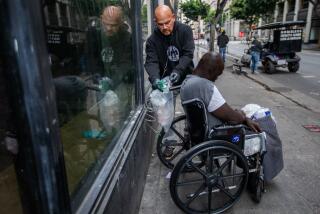Critical Moments : Lesson to Remember on Importance of Knowing CPR, First Aid
- Share via
Thirteen years ago, an accident in our home solidified my belief that every parent and child-care person should have a working knowledge of first aid and cardiopulmonary resuscitation.
We had recently moved into our house and were in the process of putting in hardwood floors in the living room. Our living room contained no furniture and was filled with a large saw and stacks of wood. The large windows adjacent to the sliding doors had no coverings.
We had just returned from the airport with a niece and nephew from Michigan, who were to spend five weeks with us, when I heard a large shattering noise coming from the living room. My 12-year-old nephew had crashed through a non-safety glass window leading to the back yard.
Until that moment I had always thought of myself as rational and safety conscious. I had made certain that my sister had sent a medical release form for her children in case they needed care while they were with us. And, before moving into the house, we had arranged to have a safety pool.
Suddenly, I learned not only the danger of non-safety glass, but that I was totally unprepared to handle the crisis.
The only others in the house were my two children, ages 6 and 4, and my niece, 7. I failed to call 911, failed to instruct the children to do so. I picked up my nephew, carried him outdoors and into the middle of my cul-de-sac and screamed for help from neighbors.
Fortunately, some were home.
One neighbor called paramedics and another, whom I hadn’t yet met and turned out to be a physician, helped apply pressure to control the bleeding until the paramedics arrived. My nephew required more than 200 stitches to mend his legs and arms. The following day, I began having non-safety glass replaced in our house and made inquiries into first aid and CPR classes.
The experience drove home the point to me that I lacked the basic knowledge needed to deal with a medical emergency. I believe that had I then had the experience of classes in CPR and general first aid, I would have reacted with some degree of rationality and confidence.
Because I live in a home with a swimming pool, I knew that cardiopulmonary resuscitation, the act of mouth-to-mouth breathing and chest compression (CPR), was a skill I needed to know. And I realized that if a visiting grandparent were to suffer a heart attack, I would want desperately to be able to help.
In the ensuing 13 years, I have continued to stay abreast of first aid and taken CPR classes through the YMCA and local schools. I have encouraged my teen-agers to take these classes, too.
On a recent Wednesday evening, I attended a CPR class taught by Bob Keilholtz, a Solana Beach firefighter and certified CPR instructor. On this particular evening, the San Dieguito Bank in Encinitas had donated use of their facility for the four-hour evening class, which cost participants $12.50.
“Most people say, ‘I don’t need to know this. We have paramedics to help save lives,’ ” Keilholtz said in his introduction. “But,” he said, “we have to rely on people like you. You are the people who are going to make a difference if you start CPR immediately.”
The class was appropriate for community members of varying ages and interests. Some attendees required certification for CPR as medical personnel; others in the class were interested in learning for personal reasons.
Keilholtz offered no specific parameters about age appropriateness for the class but did say he felt that even if the student was physically not able to administer CPR, he or she could at least learn to recognize a medical emergency that would precipitate calling 911 for assistance.
Two students, Verity Bryant, 11, and her brother Charles, 10, from Encinitas, who were accompanied by their mother, Gayle, learned the procedures quite well.
The class covered a number of safety issues, from how to recognize a person having a heart attack to responding to drowning and electrical accidents.
Some of Keilholtz’s most basic advice: Dial 911 immediately if there is a problem. Next to the telephone, note your address and cross streets. (It is helpful for baby-sitters and visitors--even yourself if you are distraught--to have that information written down.)
We were shown a video of the rescue and subsequent use of CPR on a child who was drowning in a pool. We saw a video of a beach drowning and, lastly, one of a young man, who while trimming trees hit a power line and was electrocuted.
While these films were uncomfortable to watch, they underscored the everyday occurrences that require CPR. We then viewed a video on administering CPR. Most helpful were the distinct examples of commonly made errors.
After viewing the videos, we began our hands-on experience. There were sufficient adult mannequins available for each of the 40 participants to practice administering CPR. Also available were cutaway mannequins that allowed us to see the lungs inflate and distinguish the different organs affected by CPR.
There is special instruction in giving CPR to children, who have a smaller lung capacity.
We practiced administering CPR with the help of Keilholtz and his assistant that evening, Kim Williams of San Marcos. Kim is an animal health technician at the San Diego Zoo, where she has had some unusual opportunities to use her skills. “I have administered CPR even on animals--from small birds to a Southern White Rhinoceros,” she said.
Various scenarios of accidents were presented to the class as we repeated the process of CPR. There was ample opportunity in the four hours to practice the procedure.
At the conclusion of the class, we received our CPR cards.
*
The American Red Cross, hospitals and YMCAs provide instruction in CPR and first aid. The American Heart Assn. teaches CPR. The Red Cross and Heart Assn. offer instruction in Spanish. The price of the classes, number of students per mannequin, and material covered in the class will vary according to the agency.
American Red Cross
North Coastal: 757-5403
North Inland: 745-3221
American Heart Assn.
San Diego County Chapter: 497-5797
National Health and Safety Education
Bob Keilholtz, 942-0453






